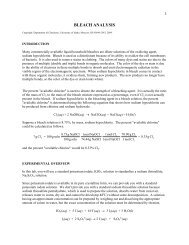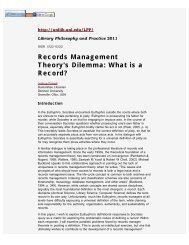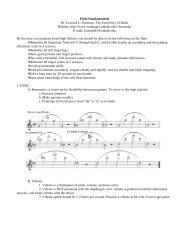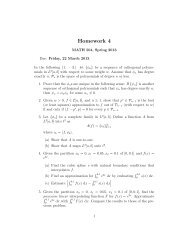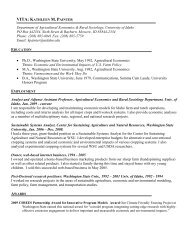Gandhi, Ahimsa, and the Self - University of Idaho
Gandhi, Ahimsa, and the Self - University of Idaho
Gandhi, Ahimsa, and the Self - University of Idaho
Create successful ePaper yourself
Turn your PDF publications into a flip-book with our unique Google optimized e-Paper software.
Like <strong>the</strong> Buddhists, <strong>G<strong>and</strong>hi</strong> believed that ashimsa without compassion is nothing, just as gold is an<br />
amorphous material without goldsmith's artistic shape or <strong>the</strong> root is nothing without <strong>the</strong> magnificent<br />
tree. 12 This means that for both <strong>G<strong>and</strong>hi</strong> <strong>and</strong> Buddhism ahimsa is an enabling virtue in <strong>the</strong> context <strong>of</strong> a<br />
comprehensive social ethics.<br />
<strong>G<strong>and</strong>hi</strong> actually allowed many exceptions to ahimsa, based on very realistic <strong>and</strong> pragmatic<br />
considerations, exceptions that sc<strong>and</strong>alized many Hindus <strong>and</strong> Jains. His view is summed up in <strong>the</strong><br />
surprising qualification that "all killing is not himsa," 13 <strong>and</strong> his equally provocative imperative that it is<br />
better to fight an aggressor than to be a coward. In contrast to <strong>the</strong> Jain position, <strong>G<strong>and</strong>hi</strong>'s ahimsa is<br />
reactive <strong>and</strong> flexible not passive <strong>and</strong> absolute. Throughout October 1928, <strong>G<strong>and</strong>hi</strong> carried on a lively<br />
debate with various respondents in Young India. <strong>G<strong>and</strong>hi</strong> defended his decision to euthanize an<br />
incurable calf, <strong>and</strong> even went on to list <strong>the</strong> conditions for human euthanasia that do not violate ahimsa.<br />
He also thought that tigers, snakes, <strong>and</strong> rabid dogs might have to be killed if <strong>the</strong>y threaten human life.<br />
The vow <strong>of</strong> ahimsa is indeed absolute, but <strong>the</strong> exigencies <strong>of</strong> human finitude force us, tragically, to<br />
violate this vow every day. Unlike <strong>the</strong> casuistry <strong>of</strong> <strong>the</strong> Vedic tradition, which somehow transformed <strong>the</strong><br />
himsa <strong>of</strong> animal sacrifice or military conquest into <strong>the</strong> highest forms <strong>of</strong> ahimsa, <strong>G<strong>and</strong>hi</strong> insisted that we<br />
must accept all <strong>the</strong> injury we do as culpable.<br />
In a response to queries about apparent inconsistencies--e.g., holding to advaita <strong>and</strong> dvaita at<br />
<strong>the</strong> same time--<strong>G<strong>and</strong>hi</strong> answered that he believed in Jain view <strong>of</strong> <strong>the</strong> many-sidedness (anekantavada)<br />
<strong>of</strong> reality, <strong>and</strong> that his "anekantavada is <strong>the</strong> result <strong>of</strong> <strong>the</strong> twin doctrine <strong>of</strong> satya <strong>and</strong> ahimsa." 14 If one<br />
thinks <strong>of</strong> <strong>G<strong>and</strong>hi</strong>'s view <strong>of</strong> relative truth <strong>and</strong> how this would preclude one thinking ill <strong>of</strong> o<strong>the</strong>rs with<br />
differing beliefs, <strong>the</strong>n <strong>the</strong> alliance with Jain anekantavada is a natural one. In <strong>the</strong> same passage <strong>G<strong>and</strong>hi</strong><br />
continues: "Formerly I used to resent <strong>the</strong> ignorance <strong>of</strong> my opponents. Today I can love <strong>the</strong>m because I




